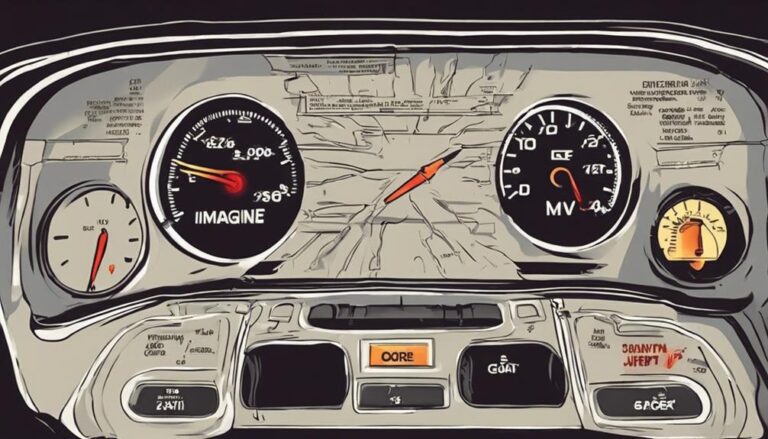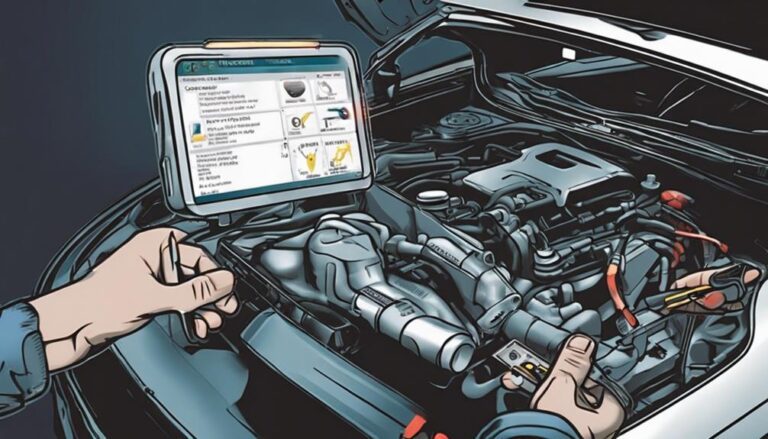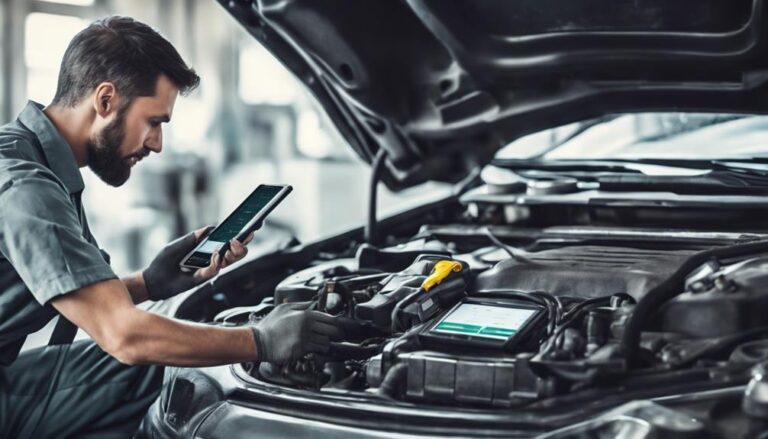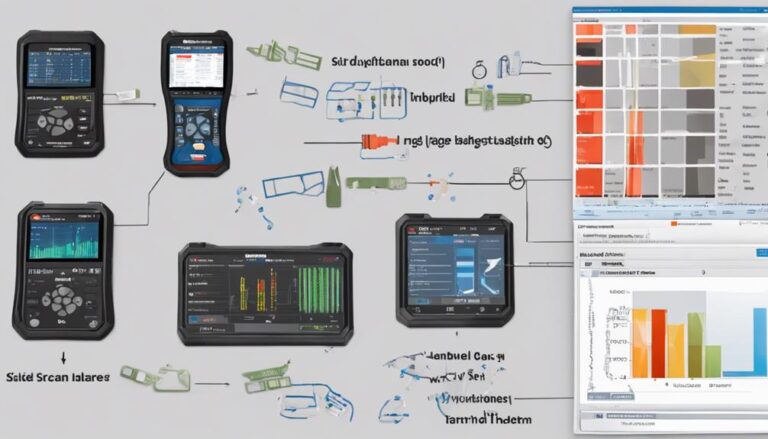Why Is My Check Engine Light On?
Have you ever wondered why your check engine light is on? Did you know that according to the CarMD Vehicle Health Index, approximately 10% of drivers have their check engine light illuminated at any given time?
When this light comes on, it's easy to feel a sense of concern or uncertainty. But fear not, understanding the reasons behind this warning can help you navigate potential issues and keep your vehicle running smoothly.
So, let's explore some common causes and what steps you can take to address them effectively.
Key Takeaways
- Loose gas cap or faulty components trigger the light.
- Oxygen sensor failure impacts emissions and fuel efficiency.
- Ignition, transmission, and wiring issues can illuminate the light.
- Catalytic converter or mass airflow sensor problems affect engine performance.
Common Causes of Check Engine Light
One of the most frequent reasons the check engine light activates is due to a loose gas cap. When this happens, it can trigger a diagnostic trouble code related to evaporative emissions troubleshooting. Checking the gas cap and ensuring it's tightened properly can often resolve this issue.
Another common cause of the check engine light is engine misfire diagnosis. An engine misfire can be caused by various factors such as faulty spark plugs, ignition coils, fuel injectors, or even vacuum leaks. Promptly addressing engine misfires is crucial as they can lead to further damage if left unresolved.
To troubleshoot these issues, utilizing an OBD-II scanner to read trouble codes can provide valuable insights into the specific problem triggering the check engine light. Visually inspecting components like the gas cap, spark plugs, and ignition coils can help identify any visible issues. However, seeking professional help for accurate diagnosis and repair is recommended to effectively address engine misfires and evaporative emissions problems indicated by the check engine light.
Impact of Oxygen Sensor Failure
Oxygen sensor failure significantly impacts vehicle performance by causing decreased fuel efficiency and increased emissions, ultimately leading to potential damage to the catalytic converter if left unaddressed. When the oxygen sensor malfunctions, your vehicle's engine control module may not receive accurate data for fuel-air mixture adjustments, resulting in poor fuel economy.
Additionally, the emissions of harmful gases such as carbon monoxide and nitrogen oxides can exceed regulatory limits, affecting air quality and compliance with emission regulations.
Preventive maintenance is crucial to avoid these issues. Timely replacement of a faulty oxygen sensor, typically costing between $100 to $250, can prevent further damage and enhance your vehicle's performance. Ignoring the check engine light and continuing to drive with a malfunctioning oxygen sensor can lead to more severe problems, including catalytic converter damage, which could escalate repair costs significantly.
Fuel Cap and Ignition Issues

The presence of a loose fuel cap or ignition issues can often trigger the check engine light in your vehicle, indicating a need for immediate attention to prevent performance issues. Here are some important facts to consider:
- A loose fuel cap is a common culprit for the check engine light coming on, affecting fuel efficiency and potentially leading to engine misfires.
- Ignition system problems, like faulty spark plugs or ignition coils, can result in engine performance loss and trigger the check engine light.
- Monitoring the proper firing of spark plugs is crucial for addressing ignition system issues and resolving check engine light concerns.
- Wiring issues, such as loose connections or damaged wires from the battery to the spark plugs, can also illuminate the check engine light, underscoring the importance of maintaining wiring integrity.
- Transmission problems may cause specific warning lights to come on, potentially leading to internal damage and triggering the check engine light, sometimes requiring fluid replacement to rectify the issue.
Understanding Catalytic Converter Problems
Understanding Catalytic Converter Problems involves recognizing the crucial role these components play in reducing harmful emissions from your vehicle.
Catalytic converters act to convert toxic gases like carbon monoxide, nitrogen oxides, and hydrocarbons into less harmful substances such as carbon dioxide, nitrogen, and water vapor.
Detecting issues with your catalytic converter is vital as problems like clogging, overheating, or physical damage can lead to decreased engine performance and increased fuel consumption.
If you notice a decline in your vehicle's efficiency or if the check engine light illuminates, it could indicate a failing catalytic converter.
When faced with such a situation, prompt attention is crucial to prevent further damage to your vehicle and the environment.
Repair options for catalytic converter problems can vary in cost, typically ranging from $200 to $600 depending on the vehicle's make and model.
Addressing catalytic converter issues promptly is essential for both your vehicle's performance and environmental well-being.
Dealing With Mass Airflow Sensor Failure
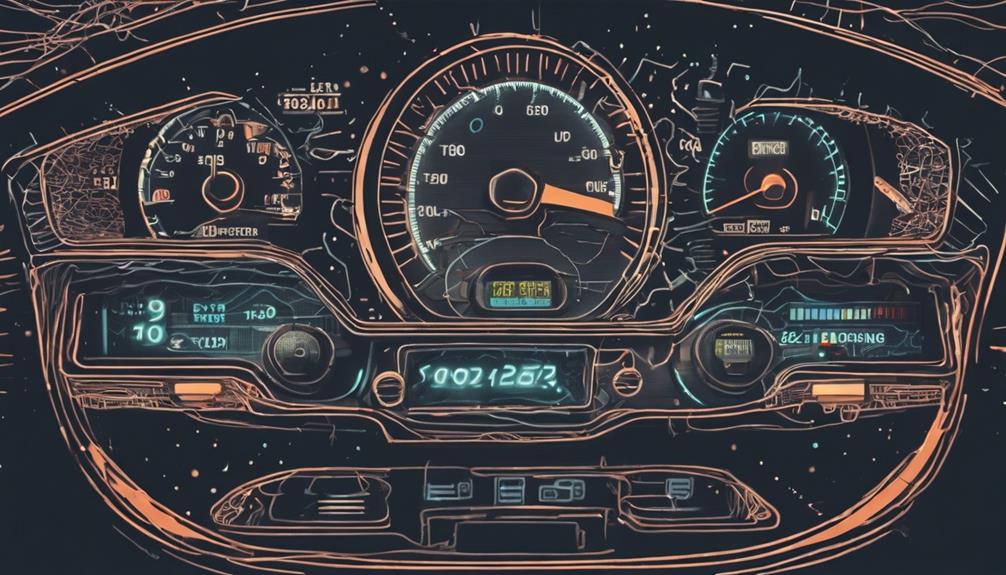
When diagnosing vehicle issues related to the check engine light, addressing mass airflow sensor failure promptly is essential for maintaining optimal engine performance and fuel efficiency.
Proper diagnosing techniques and maintenance tips for dealing with mass airflow sensor failure include:
- Check for Fault Codes: Use an OBD-II scanner to retrieve specific fault codes related to the mass airflow sensor to pinpoint the issue accurately.
- Inspect the Sensor: Visually inspect the mass airflow sensor for any signs of dirt, debris, or damage that could affect its performance.
- Clean or Replace: Try cleaning the sensor using specialized cleaner; if cleaning doesn't improve its function, consider replacing it.
- Ensure Proper Installation: When replacing the mass airflow sensor, ensure it's installed correctly to avoid any issues with readings.
- Regular Maintenance: Incorporate regular maintenance checks for the mass airflow sensor to prevent failures and maintain efficient engine operation.
Following these diagnosing techniques and maintenance tips can help you address mass airflow sensor failures effectively, ensuring your vehicle runs smoothly and efficiently.
Frequently Asked Questions
What Is the Most Common Reason for Check Engine Light?
The most common reason for the check engine light is a loose or faulty gas cap. Ignoring it can harm fuel efficiency and emissions. Tighten or replace the cap to resolve the issue inexpensively.
Is It OK to Drive With Check Engine Light On?
Driving with the check engine light on is risky for driving safety and vehicle maintenance. Ignoring it can lead to costly repairs. Address the issue promptly to prevent damage. Seek professional help for diagnosis and repairs.
Why Is My Check Engine Light on but My Car Runs Fine?
When your check engine light shines, it could be like a weather forecast for your car's inner workings. False positives or sensor misreadings affect engine efficiency. Addressing it promptly prevents hidden issues from growing.
What Is the First Thing to Check When the Check Engine Light Comes On?
When the check engine light comes on, start by checking the ignition system and fuel injectors. Ignoring these issues can lead to serious engine damage. Promptly addressing these concerns is crucial for maintaining your vehicle's performance and longevity.
Conclusion
So, the next time your check engine light comes on, don't ignore it. Addressing the issue promptly can prevent further damage and ensure your vehicle's performance and safety.
Remember, proper maintenance is key to keeping your car running smoothly. Can you afford to risk ignoring the warning signs?


